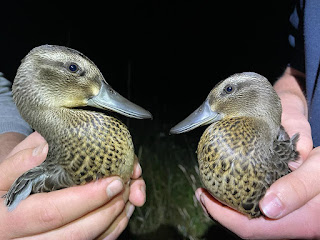The Lower Derwent Valley NNR is one of the key sites in the UK for this species as well as being a great site for visitors to have the opportunity to see them early in the season.
Garganey are Britian’s only migratory summer visitor duck species, wintering in southern Africa before heading northwards to breed, with perhaps 100-300 pairs in Britain most years. There have been several individuals present on the reserve this year, with Bank Island being a great place to see them (up to four drakes and three ducks on occasions over the last couple of months). We know at least one pair have bred with a single brood of nine hatching off and eight young successfully fledging, with two ringed. Several other ducklings have been caught here over the years (as well as the occasional adult male), and from our ringing studies we know these young birds often disperse quickly south into France after fledging, however, we would expect the odd sighting of one or two until mid-September when the last few birds can often be found lurking amongst the building autumn Teal flocks.


.jpg)
















